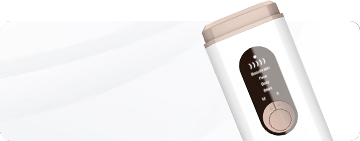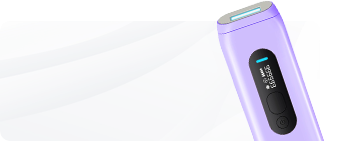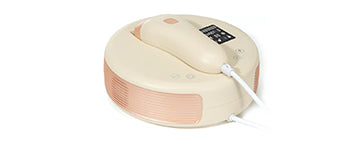How effective is IPL hair removal?
IPL, or intense pulsed light hair removal, provides many benefits to patients looking for an efficient and pain-free method to reduce unwanted hair. When patients attend multiple sessions, they typically observe a significant reduction in the thickness and quantity of hair strands, resulting in longer advantages. IPL is particularly famous for its ease because handheld devices can conveniently deliver treatments at home, removing the necessity of frequent trips to salons or clinics to obtain the desired effect.
In addition, users can quickly and safely use IPL devices designed to be user-friendly. These devices have interfaces that are accessible to those who do not have professional training. Because of this method's high level of efficacy and its capacity to treat vast treatment regions, such as the legs and the back, it is an excellent option for achieving thorough hair removal. Ingrown hairs, a typical problem connected with shaving or waxing, are also said to be reduced by product users. IPL may be used to treat a variety of body parts thanks to its adaptability, including the face, legs, arms, and underarms. You can use it even on the bikini line. Notably, intense pulsed light (IPL) is typically less painful than other procedures, such as waxing or specific laser treatments; several users have described the experience as similar to a faint, warm tingling.
IPL devices can effectively target vast areas, allowing for a quick completion of the treatment, which is an advantage that is especially helpful for people who have hectic schedules. In addition, customers frequently report a considerable reduction in hair regrowth after finishing a series of treatments, which results in hair that is thinner and lighter in color, contributing to the overall impression of a smoother appearance. The initial cost of an IPL device may appear excessive; nevertheless, research has shown that purchasing an IPL device is more cost-effective in the long run when compared to the accumulated costs involved with frequent visits to a salon for waxing or professional laser treatments. IPL also carries a lesser chance of ingrown hairs and razor bumps, typical problems associated with traditional hair removal techniques, because users apply IPL in a targeted manner. IPL, which is essential to note, is suitable for a range of skin tones, including fair to light brown, making it an option open to a wider variety of people.
Nevertheless, people can have entirely different experiences, and it is essential to follow the directions provided by the manufacturer before beginning IPL treatments. Individuals with concerns or specific skin disorders should consult with a dermatologist first, as recommended, which will help ensure that the treatments are safe and effective.
What are the side effects of IPL?
Engaging in an in-depth comparison of the adverse effects linked to the use of intense pulsed light (IPL) for hair removal and those related to traditional methods such as waxing, shaving, and epilation reveals significant differences between these approaches. IPL, known for its general reputation of being less unpleasant than its competitors, may cause transient redness, swelling, and pigment changes, especially in darker skin tones, which is especially true for people with darker skin tones. Making people aware of the possibility of suffering burns or blisters emphasizes the importance of appropriately operating the IPL device, employing proper procedures, and adhering to all applicable safety rules.
On the other hand, more traditional methods of hair removal, like waxing and shaving, come with drawbacks. Waxing, a common practice well-known for its effectiveness, might result in transient irritation and redness. Although these side effects often don't last long, they can be uncomfortable for certain people. After waxing, ingrown hairs can typically arise, especially in regions with coarse hair, which is one of the issues commonly connected with waxing. Although waxing is an efficient method for removing hair from the root, the process can occasionally cause hair to grow back into the skin, which can be uncomfortable and may even lead to inflammation.
Shaving is a practice that is frequently used and easy to acquire, but it does come with its fair share of adverse effects. Shaving can cause temporary redness and discomfort, mainly if not accurately performed. Shaving can also create ingrown hairs. When you shave, you risk developing razor bumps, essentially inflamed and irritated hair follicles, one of the most common problems associated with shaving. People with sensitive skin or prone to getting ingrown hairs may notice this effect is more pronounced. Although shaving is quick and convenient, some people find it less appealing because of the discomfort associated with razor bumps. In addition, traditional treatments increase the likelihood of experiencing an adverse reaction to the components of depilatory creams or waxes. The necessity of conducting patch tests and using caution when using a product, particularly for people with sensitive skin, cannot be overstated. Allergic reactions can manifest themselves as a rash, itching, or redness. These reactions might vary significantly from person to person, highlighting the importance of considering individualized factors when selecting a hair removal method.
People often choose between traditional methods and IPL treatments based on several criteria, such as their pain tolerance level and skin sensitivity. Even if IPL's adverse effects are only temporary, individuals should still consider them despite the treatment's reputation for being less uncomfortable. When considering an individual's specific circumstances and preferences, the guidance of professionals is extremely helpful in leading them through the decision-making process. An individual's skin type, tolerance for discomfort, and goals for removing unwanted hair all play a role in determining which hair removal procedure will be the most effective for them. Seeking the advice of a skincare specialist or a dermatologist can provide helpful insight into making this decision.
Additionally, it is crucial to emphasize the value of observing correct procedures and engaging in appropriate aftercare. By adhering to suggested protocols and taking proper post-treatment care, users can reduce the likelihood of experiencing unwanted effects, including applying moisturizer to the skin, avoiding prolonged exposure to direct sunlight, and abstaining from vigorous scrubbing in the treated regions, regardless of their selected treatment approach.
In conclusion, it is essential to have a well-informed decision-making process to have a solid awareness of the intricacies of the adverse effects of traditional hair removal treatments and IPL. Individuals must weigh each approach's distinct set of benefits and potential negatives in light of their tastes and life circumstances. Whether one chooses to go with the cutting-edge technology of IPL or the tried-and-true practices of waxing and shaving, a well-informed approach in conjunction with the direction of a trained professional is the best way to ensure a more satisfying and comfortable hair removal experience.
Is it OK to do IPL every day?
Because of the many factors that might affect the treatment's performance and safety, undergoing IPL (intense pulsed light) hair removal is typically not recommended daily. The natural hair growth cycle is crucial since it is essential to having excellent IPL results. Three main phases make up the hair development cycle. These phases are known, respectively, as the anagen (active growth), catagen (transitional), and telogen (resting) phases. Intentionally timed at intervals ranging from two weeks to four weeks, IPL treatments effectively target hair at its different stages of growth.
Engaging in daily IPL sessions could disturb this natural growth cycle, which will, in turn, damage the ability to target hair follicles most effectively. Since IPL's efficiency is strongly related to addressing hair at different stages of growth, the consequence could be less desirable outcomes. By adhering to the suggested treatment schedule, users can deliberately plan their IPL sessions to capture hair in its active growth phase, which ensures the treatment is as successful as possible during the user's treatment.
In addition, it is essential to consider how the skin reacts to the IPL. Performing IPL treatments regularly, especially daily, may increase the risk of skin sensitivity, irritation, and potentially harmful effects if done too frequently. IPL treatments can create transient skin flushing, and exposing the same area to daily sessions may not provide adequate time for the skin to recover in between sessions. Persistent sessions can increase the danger of irritation, discomfort, or other skin reactions, which would, in turn, undermine the procedure's overall safety and acceptability.
It is necessary to adhere to the treatment schedule the manufacturer prescribes to maintain a healthy balance between attaining the best results and preserving the skin's safety. The manufacturers deduce particular guidelines from the design of the device, the properties of the emitted light, and the anticipated physiological response from the skin. Suppose you deviate from these suggestions, especially by doing sessions daily. In that case, you risk not only reducing the efficiency of the treatment but also exposing your skin to significant health hazards.
Those contemplating or undergoing IPL treatments should consult a dermatologist or skincare specialist, especially if there are questions or concerns regarding the optimum treatment frequency. These professionals can provide personalized guidance based on unique aspects such as skin type, hair characteristics, and the specific IPL equipment used. A dermatologist's knowledge and experience can help tailor the treatment plan to maximize its effectiveness while minimizing the risk of unwanted effects, ensuring a safe and individualized approach to IPL hair removal. Regularly performing IPL treatments is generally not advised due to the possibility of interfering with the normal cycle of hair development, the increased risk of skin irritation, and the significance of adhering to the parameters provided by the manufacturer to achieve the best possible results while remaining safe.
When should I stop using IPL?
Selecting when to stop removing hair with IPL (intense pulsed light) is sophisticated and influenced by several elements, each of which is integral in determining the most appropriate course of action. When patients reach the level of hair loss they desire, they frequently question whether they should completely stop IPL treatments or move into a maintenance phase during which they have fewer sessions on a more regular basis. This critical step in the decision-making process requires a thorough assessment of a wide range of factors, including the efficiency of the treatment and the individual's general health and happiness.
Paying attention to how the hair grows can significantly aid in decision-making. Users of IPL often observe a diminishment in the coarseness and pigmentation of their hair as their treatments advance. These discernible shifts in appearance indicate how well the treatment works and contribute to the user's assessment of whether or not the desired result has been achieved. Suppose the user has reached a suitable degree of hair removal that aligns with their expectations. In that case, they may conclude that continuing with IPL is no longer necessary and terminate treatment.
Throughout the entire process of undergoing IPL, skin sensitivity and unfavorable responses are vital concerns that require constant attention. Persistent problems such as redness, irritation, or discomfort may alert users to consider whether the treatment frequency or intensity should be altered. Individuals' sensitivity levels can vary greatly, and having a solid awareness of how their skin reacts to IPL treatments enables a more tailored and flexible application of the technology. Users are advised to prioritize the health of their skin and the comfort of their complexion, making any required adjustments to the treatment plan to address particular difficulties.
Additionally, the circumstances of one's life and state of health significantly impact when to stop receiving IPL treatments. Alterations in one's state of health could affect the decision-making process. It is commonly recommended that women who are pregnant refrain from undergoing some cosmetic operations while they are carrying their child; in these kinds of circumstances, it is vital to consult a healthcare practitioner. In addition, attaining the maximum number of treatments suggested by the manufacturer of the IPL equipment is a tangible aspect that plays a role in the decision to terminate therapy. The device manufacturers set precise instructions about the number of sessions or overall usage to ensure that users are safe and that the device is operating at its full potential. It is essential to adhere to these rules to preserve the device's effectiveness and avoid any potential dangers connected with excessive use.
Consulting a dermatologist or other healthcare professional adds a layer of expertise, which improves decision-making. These experts have the necessary information to provide individualized guidance, considering the specific health concerns, skin type, and any other peculiar circumstances of the individual being counseled. Their advice is especially beneficial to users who have issues or doubts about giving up their IPL treatments because it allays such fears and doubts. When users and medical experts work together to make decisions, this increases the likelihood that such decisions will be well-informed, risk-free, and in line with the individual's overall health and well-being.
Determining the appropriate time to stop receiving IPL hair removal treatment involves several steps and considerations. We suggest users evaluate the results attained, keep an eye on any changes in skin sensitivity, and consider any life events or shifts in their health. It is necessary to adhere to the instructions provided by the device's manufacturer. Additionally, seeking the advice of a dermatologist or other healthcare professional ensures a well-informed and individualized approach to decision-making. Individuals can confidently traverse the conclusion of their IPL journey by incorporating these variables, allowing them to feel content with their results and confident in their general skin health.






